Easy Heat® EH-38 Automatic Thermostat for Freeze Free® Heating Cables
Description
The EH38 thermostatically controlled device is used with the Freeze Free® heating cables, and automatically turns on at 38 degrees F (3 degrees C) and turns off at 50 degrees F (10 degrees C)., reducing the risk of frozen pipes while saving energy and eliminating the need to unplug cables each spring. It can also be used to control other electrical devices that need to be activated when the temperature approaches the freezing point. The EH38 thermostat is rated at 15 amps with resistive load at 125 Volt, and is UL Listed to US and Canadian Safety Standards.
- Power indicator light
- Turns on at 38°F/3°C — Off at 50°F/10°C
- 125 Volts, 15 Amps
- 1800W maximum
- For Dry Location Only
- No wiring necessary, just plug-in
- For use with Freeze Free® heating cables, heat lamps, electric Heaters and engine warmers.
Thermostatically Controlled Device
- Automate heating cable installations in dry locations for savings in energy and cost with the simple yet powerful EH38 thermostatically controlled device from Easy Heat.
- Self-regulating heating cables, such as Easy Heat’s Freeze Free,® generally do not require thermostatic control: the heat output and energy usage of these cables are reduced as temperatures rise. Without on/off control, however, these cables are energized all the time.
- When installed, the convenient EH38 automatically energizes the cable at temperatures lower than 38°F/3°C and then shuts off power when the temperature rises to 50°F/10°C. Further, the EH38 extends cable life by reducing operation time, especially in the summer, while eliminating the hassle of having to unplug the cable each spring. Most importantly, it reduces the risks of frozen pipes if the cable is not plugged in when the temperature falls.
- Installation is easy. Simply unplug the heating cable, plug the EH38 into the receptacle and then insert the heating cable plug into the EH38. The handy EH38 can also be used to control other electrical devices that need to be activated when temperatures approach the freezing point.
